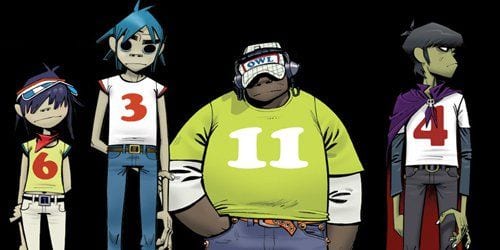
The year is 2001. Commercialism in music has reached a fever pitch. Corporation-designed music groups like the Backstreet Boys, ‘N Sync, and Destiny’s Child have all topped recent Billboard charts. The tug of war between digital music consumers and media conglomerates is in its infancy. The initial Internet explosion, which made millionaires out of college dropouts in the ’90s, is only a fading spark. MySpace, YouTube, and Twitter (and the dreaded return of tapered jeans to fashion) are only distant rest stops on the road to come.
In the middle of all this is born the self-titled debut album from a virtual band composed of a ragtag quartet of computer-animated anti-superheroes playing a unique, infectious mishmash of hip-hop, rock, and electronic music — the popular music styles of the day.
And so we were introduced to Gorillaz, the brainchild of rock musician Damon Albarn of Blur fame and Tank Girl cartoonist Jamie Hewlett. On the surface, Gorillaz was a project that quaked with the commercialism of the day. Was it a subversive artistic declaration on the state of music? Was it a blatant attempt to sell records? Was it the first significant Internet-ready commercial exploit of the 21st century? These questions, which the Gorillaz’ debut elicited to varying degrees from music fans, are what made the band such a successful experiment and what led me at the time to join the masses in hailing the group as the future of music.
It is now nearly a decade later and the future of music has arrived. The Gorillaz’ debut effort, of which over seven million copies have been sold, did indeed foreshadow much that has happened in music over the last nine years: the increasing reliance on Internet media, including video, games, and social networking, to promote bands; the melding of hip-hop, rock, and electronic elements in pop music; and the collaborative nature of modern commercial album production.
While much in music has changed since their 2001 debut, Gorillaz, now with the release of their third full-length LP, Plastic Beach, have essentially stayed the same. The band is no longer the future of music. Indeed, 2D, Murdoc, Russel, and Noodle — the band’s animated members — are simply purveyors of the craft they originally developed, which is practiced today by countless other artists. This isn’t necessarily a bad thing. On the contrary, the Gorillaz stand head and shoulders above most of their progeny and have further perfected their art on Plastic Beach. The album includes even more great collaborations than its predecessors — Lou Reed, Mos Def, and Bobby Womack are just a few of the guest artists and this time around, the band’s trademark brand of electro-funk-hip-pop is more focused, with tighter production and more sure-fire hooks. Also, Plastic Beach continues Gorillaz’ tradition of utilizing animation and technology to great effect — the centerpiece of the group’s Web site is an adventure video game featuring band members, each band member stars in a YouTube album teaser, and there’s a music video in which a maniacal Bruce Willis engages in a crazy desert car chase with the group. All that being said, Gorillaz, by remaining “virtually” the same, are no longer in a position to make any grand artistic statements about commercialism in art. Instead, the band’s creators seem content to rest on their very real — not virtual — laurels.
Plastic Beach contains some of the best Gorillaz’ songs to date and is the best place to start if you’ve never heard the band. The album’s first single, “Stylo”, is a ’70s-esque electro funk gem featuring Mos Def’s understated rhyming and Womack’s soul crooning. “On Melancholy Hill” takes a page out the Pet Shop Boys’ book with blissful, fuzzed-out pop that would sound perfectly at home in the ’80s. The warm fuzzies continue on “Broken”, which contains some of the album’s best production. Enjoyable chill-out ballad “Empire Ants”, with a heavy trip-hop swizzle stirred in, borrows from the playbook of bedroom electronica producers like Moby and Mylo. “Some Kind of Nature”, perhaps the most intriguing collaboration on the album, juxtaposes Lou Reed’s trademark halting talk-singing with Albarn’s syrupy sweet harmonies over a buzzing hip-hop beat.
As with its predecessors, and most albums that contain such a large cadre of collaborators, Plastic Beach sounds uneven on occasion. The introductory track, which features a full orchestra, comes off as pretentious and superfluous with Albarn flaunting the now-immense resources at his disposal. And “Welcome to the World of the Plastic Beach”, the theme song of the album, with guest rapper Snoop Dogg, comes off more as adolescent play than satire.
Fortunately, Plastic Beach‘s weaknesses are few and far between. Overall, while the album isn’t an artistic triumph or grand satirical gesture, it is an enjoyable ride and is the best place to start if you just want a taste of Albarn’s post-Blur musical prowess and Hewlett’s animation wizardry. Gorillaz are no longer the revolutionary squad they once were: the band that rejected a Mercury Award nomination, shared the stage with Madonna at the Grammy Awards, and promised us an eye-opening full-length motion picture is long gone. In its place is an entertaining multimedia product and a reminder of a time when four music-making cartoon characters had the potential to raise eyebrows and wreak political mayhem.
